MGT 201: Siemens Case Study Analysis - Strategy and Leadership
VerifiedAdded on 2023/01/05
|10
|2608
|92
Case Study
AI Summary
This case study analyzes Siemens, a German multinational company, focusing on its corporate strategies, leadership styles, and impact on culture. The analysis examines two case studies, "Siemens A: exploring the future" and "Siemens B: Implementing the strategy," highlighting the company's strategic shifts, including Vision 2020 and digital transformation initiatives. The study evaluates the success of these strategies, particularly the adoption of an ownership culture and the challenges related to diversity and market optimization. Recommendations include enhancing market analysis by adopting an "outside-in" perspective and promoting diversification within decentralized business units. The paper also suggests leveraging the ownership culture and leadership styles to maximize employee potential and improve the company's performance. The study concludes by emphasizing the importance of adapting to the changing technological and business environment for sustainable corporate success.

Running head: SEIMENS: CASE STUDY
SEIMENS: CASE STUDY
Name of the student
Name of the University
Author Note
SEIMENS: CASE STUDY
Name of the student
Name of the University
Author Note
Paraphrase This Document
Need a fresh take? Get an instant paraphrase of this document with our AI Paraphraser
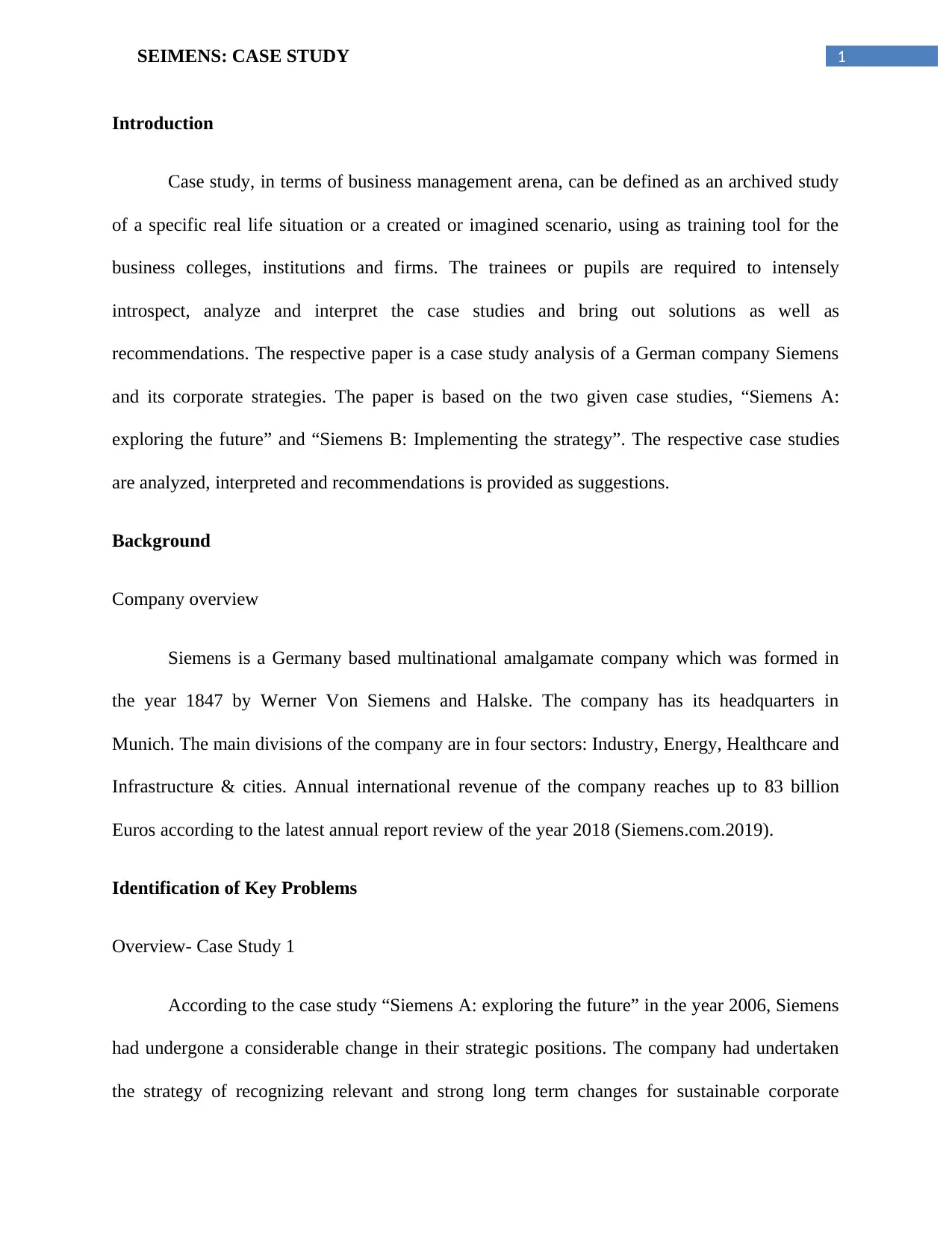
1SEIMENS: CASE STUDY
Introduction
Case study, in terms of business management arena, can be defined as an archived study
of a specific real life situation or a created or imagined scenario, using as training tool for the
business colleges, institutions and firms. The trainees or pupils are required to intensely
introspect, analyze and interpret the case studies and bring out solutions as well as
recommendations. The respective paper is a case study analysis of a German company Siemens
and its corporate strategies. The paper is based on the two given case studies, “Siemens A:
exploring the future” and “Siemens B: Implementing the strategy”. The respective case studies
are analyzed, interpreted and recommendations is provided as suggestions.
Background
Company overview
Siemens is a Germany based multinational amalgamate company which was formed in
the year 1847 by Werner Von Siemens and Halske. The company has its headquarters in
Munich. The main divisions of the company are in four sectors: Industry, Energy, Healthcare and
Infrastructure & cities. Annual international revenue of the company reaches up to 83 billion
Euros according to the latest annual report review of the year 2018 (Siemens.com.2019).
Identification of Key Problems
Overview- Case Study 1
According to the case study “Siemens A: exploring the future” in the year 2006, Siemens
had undergone a considerable change in their strategic positions. The company had undertaken
the strategy of recognizing relevant and strong long term changes for sustainable corporate
Introduction
Case study, in terms of business management arena, can be defined as an archived study
of a specific real life situation or a created or imagined scenario, using as training tool for the
business colleges, institutions and firms. The trainees or pupils are required to intensely
introspect, analyze and interpret the case studies and bring out solutions as well as
recommendations. The respective paper is a case study analysis of a German company Siemens
and its corporate strategies. The paper is based on the two given case studies, “Siemens A:
exploring the future” and “Siemens B: Implementing the strategy”. The respective case studies
are analyzed, interpreted and recommendations is provided as suggestions.
Background
Company overview
Siemens is a Germany based multinational amalgamate company which was formed in
the year 1847 by Werner Von Siemens and Halske. The company has its headquarters in
Munich. The main divisions of the company are in four sectors: Industry, Energy, Healthcare and
Infrastructure & cities. Annual international revenue of the company reaches up to 83 billion
Euros according to the latest annual report review of the year 2018 (Siemens.com.2019).
Identification of Key Problems
Overview- Case Study 1
According to the case study “Siemens A: exploring the future” in the year 2006, Siemens
had undergone a considerable change in their strategic positions. The company had undertaken
the strategy of recognizing relevant and strong long term changes for sustainable corporate
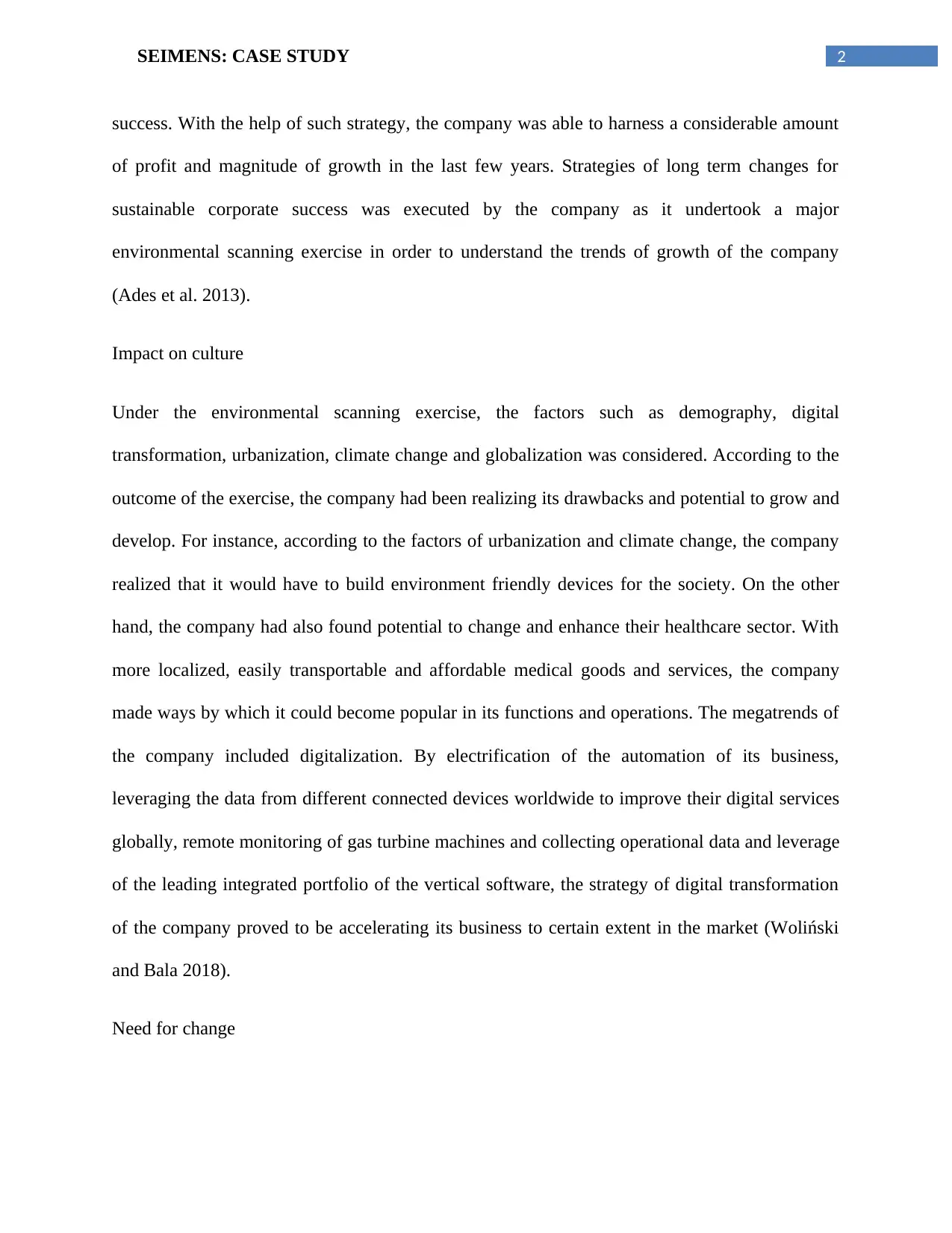
2SEIMENS: CASE STUDY
success. With the help of such strategy, the company was able to harness a considerable amount
of profit and magnitude of growth in the last few years. Strategies of long term changes for
sustainable corporate success was executed by the company as it undertook a major
environmental scanning exercise in order to understand the trends of growth of the company
(Ades et al. 2013).
Impact on culture
Under the environmental scanning exercise, the factors such as demography, digital
transformation, urbanization, climate change and globalization was considered. According to the
outcome of the exercise, the company had been realizing its drawbacks and potential to grow and
develop. For instance, according to the factors of urbanization and climate change, the company
realized that it would have to build environment friendly devices for the society. On the other
hand, the company had also found potential to change and enhance their healthcare sector. With
more localized, easily transportable and affordable medical goods and services, the company
made ways by which it could become popular in its functions and operations. The megatrends of
the company included digitalization. By electrification of the automation of its business,
leveraging the data from different connected devices worldwide to improve their digital services
globally, remote monitoring of gas turbine machines and collecting operational data and leverage
of the leading integrated portfolio of the vertical software, the strategy of digital transformation
of the company proved to be accelerating its business to certain extent in the market (Woliński
and Bala 2018).
Need for change
success. With the help of such strategy, the company was able to harness a considerable amount
of profit and magnitude of growth in the last few years. Strategies of long term changes for
sustainable corporate success was executed by the company as it undertook a major
environmental scanning exercise in order to understand the trends of growth of the company
(Ades et al. 2013).
Impact on culture
Under the environmental scanning exercise, the factors such as demography, digital
transformation, urbanization, climate change and globalization was considered. According to the
outcome of the exercise, the company had been realizing its drawbacks and potential to grow and
develop. For instance, according to the factors of urbanization and climate change, the company
realized that it would have to build environment friendly devices for the society. On the other
hand, the company had also found potential to change and enhance their healthcare sector. With
more localized, easily transportable and affordable medical goods and services, the company
made ways by which it could become popular in its functions and operations. The megatrends of
the company included digitalization. By electrification of the automation of its business,
leveraging the data from different connected devices worldwide to improve their digital services
globally, remote monitoring of gas turbine machines and collecting operational data and leverage
of the leading integrated portfolio of the vertical software, the strategy of digital transformation
of the company proved to be accelerating its business to certain extent in the market (Woliński
and Bala 2018).
Need for change
⊘ This is a preview!⊘
Do you want full access?
Subscribe today to unlock all pages.

Trusted by 1+ million students worldwide
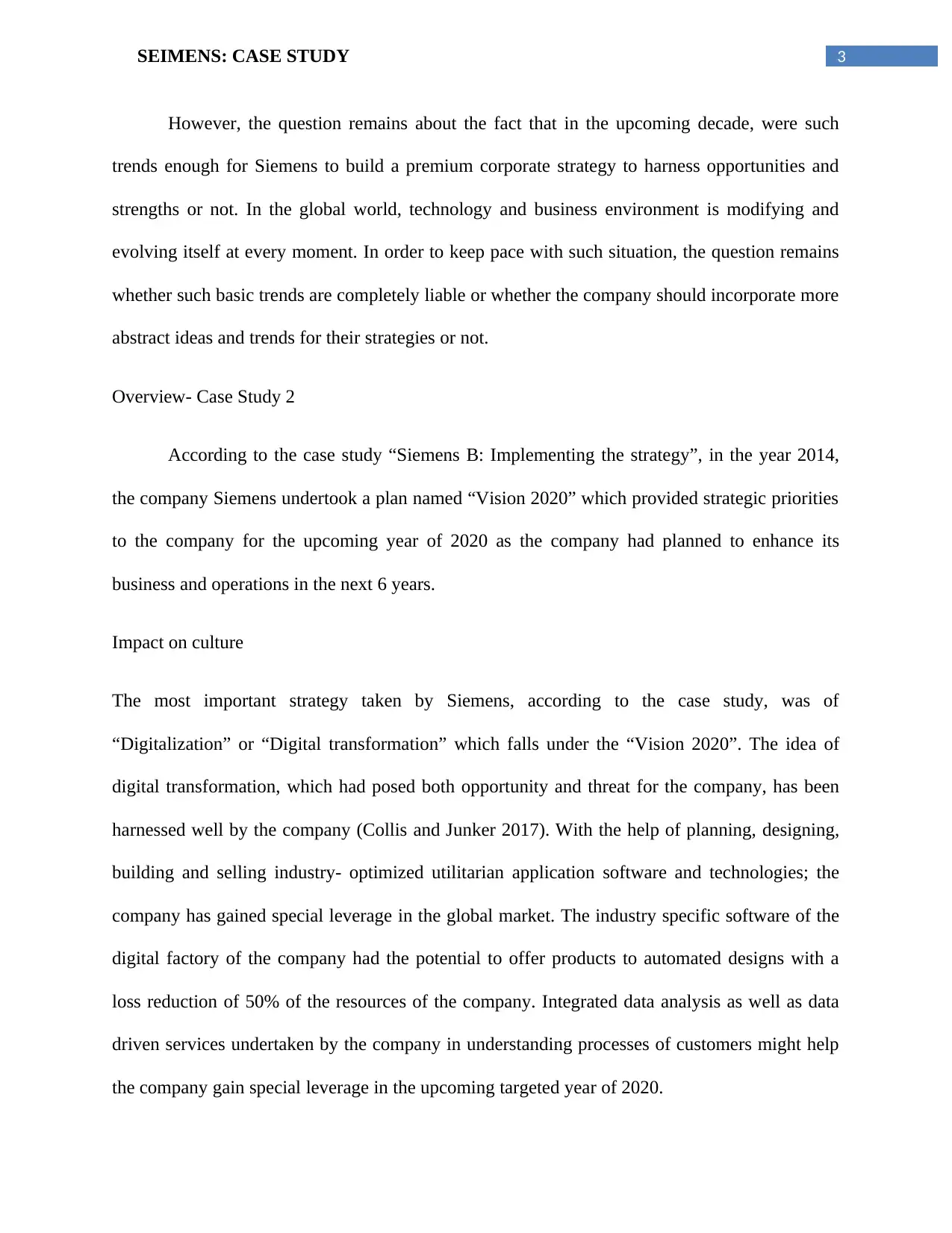
3SEIMENS: CASE STUDY
However, the question remains about the fact that in the upcoming decade, were such
trends enough for Siemens to build a premium corporate strategy to harness opportunities and
strengths or not. In the global world, technology and business environment is modifying and
evolving itself at every moment. In order to keep pace with such situation, the question remains
whether such basic trends are completely liable or whether the company should incorporate more
abstract ideas and trends for their strategies or not.
Overview- Case Study 2
According to the case study “Siemens B: Implementing the strategy”, in the year 2014,
the company Siemens undertook a plan named “Vision 2020” which provided strategic priorities
to the company for the upcoming year of 2020 as the company had planned to enhance its
business and operations in the next 6 years.
Impact on culture
The most important strategy taken by Siemens, according to the case study, was of
“Digitalization” or “Digital transformation” which falls under the “Vision 2020”. The idea of
digital transformation, which had posed both opportunity and threat for the company, has been
harnessed well by the company (Collis and Junker 2017). With the help of planning, designing,
building and selling industry- optimized utilitarian application software and technologies; the
company has gained special leverage in the global market. The industry specific software of the
digital factory of the company had the potential to offer products to automated designs with a
loss reduction of 50% of the resources of the company. Integrated data analysis as well as data
driven services undertaken by the company in understanding processes of customers might help
the company gain special leverage in the upcoming targeted year of 2020.
However, the question remains about the fact that in the upcoming decade, were such
trends enough for Siemens to build a premium corporate strategy to harness opportunities and
strengths or not. In the global world, technology and business environment is modifying and
evolving itself at every moment. In order to keep pace with such situation, the question remains
whether such basic trends are completely liable or whether the company should incorporate more
abstract ideas and trends for their strategies or not.
Overview- Case Study 2
According to the case study “Siemens B: Implementing the strategy”, in the year 2014,
the company Siemens undertook a plan named “Vision 2020” which provided strategic priorities
to the company for the upcoming year of 2020 as the company had planned to enhance its
business and operations in the next 6 years.
Impact on culture
The most important strategy taken by Siemens, according to the case study, was of
“Digitalization” or “Digital transformation” which falls under the “Vision 2020”. The idea of
digital transformation, which had posed both opportunity and threat for the company, has been
harnessed well by the company (Collis and Junker 2017). With the help of planning, designing,
building and selling industry- optimized utilitarian application software and technologies; the
company has gained special leverage in the global market. The industry specific software of the
digital factory of the company had the potential to offer products to automated designs with a
loss reduction of 50% of the resources of the company. Integrated data analysis as well as data
driven services undertaken by the company in understanding processes of customers might help
the company gain special leverage in the upcoming targeted year of 2020.
Paraphrase This Document
Need a fresh take? Get an instant paraphrase of this document with our AI Paraphraser
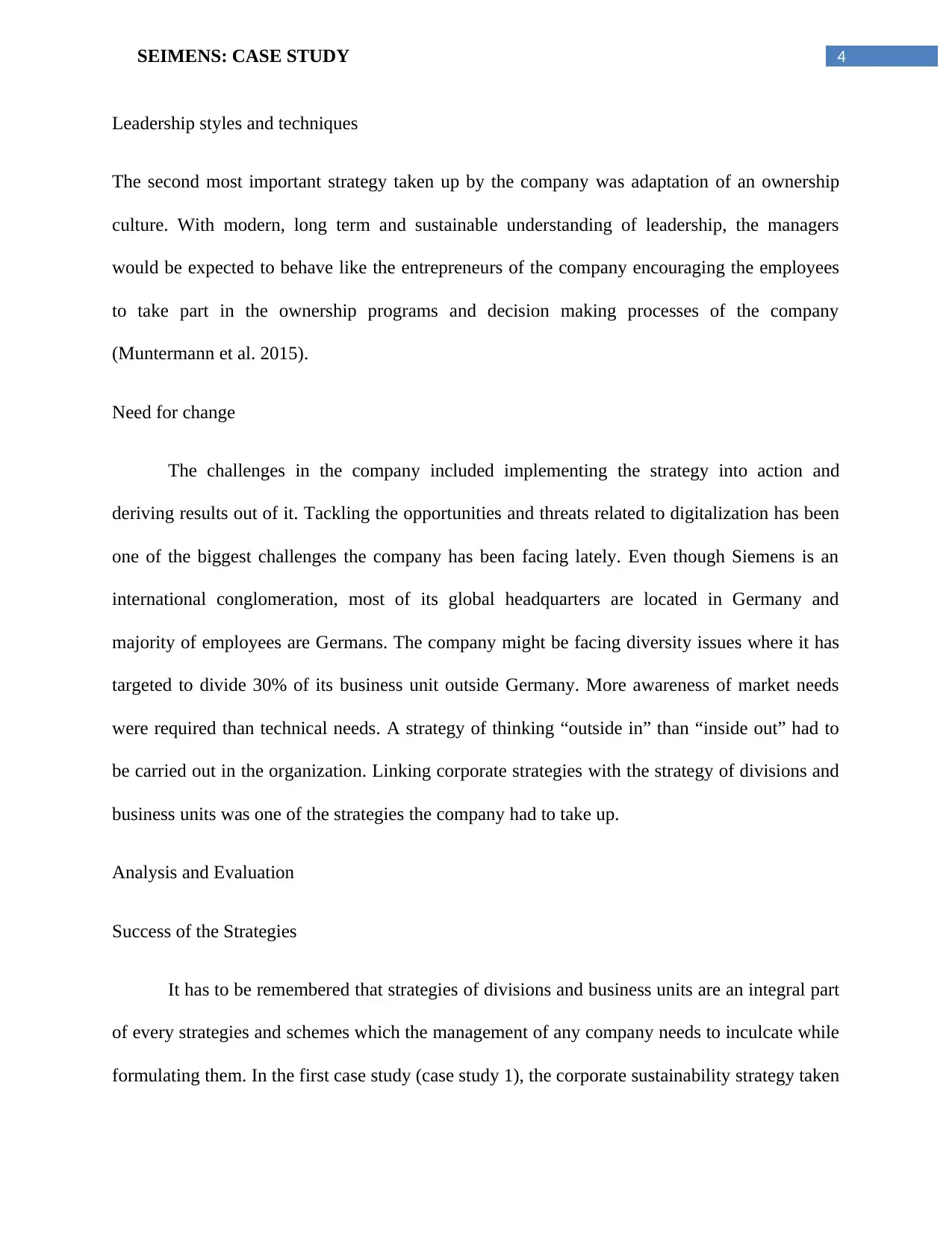
4SEIMENS: CASE STUDY
Leadership styles and techniques
The second most important strategy taken up by the company was adaptation of an ownership
culture. With modern, long term and sustainable understanding of leadership, the managers
would be expected to behave like the entrepreneurs of the company encouraging the employees
to take part in the ownership programs and decision making processes of the company
(Muntermann et al. 2015).
Need for change
The challenges in the company included implementing the strategy into action and
deriving results out of it. Tackling the opportunities and threats related to digitalization has been
one of the biggest challenges the company has been facing lately. Even though Siemens is an
international conglomeration, most of its global headquarters are located in Germany and
majority of employees are Germans. The company might be facing diversity issues where it has
targeted to divide 30% of its business unit outside Germany. More awareness of market needs
were required than technical needs. A strategy of thinking “outside in” than “inside out” had to
be carried out in the organization. Linking corporate strategies with the strategy of divisions and
business units was one of the strategies the company had to take up.
Analysis and Evaluation
Success of the Strategies
It has to be remembered that strategies of divisions and business units are an integral part
of every strategies and schemes which the management of any company needs to inculcate while
formulating them. In the first case study (case study 1), the corporate sustainability strategy taken
Leadership styles and techniques
The second most important strategy taken up by the company was adaptation of an ownership
culture. With modern, long term and sustainable understanding of leadership, the managers
would be expected to behave like the entrepreneurs of the company encouraging the employees
to take part in the ownership programs and decision making processes of the company
(Muntermann et al. 2015).
Need for change
The challenges in the company included implementing the strategy into action and
deriving results out of it. Tackling the opportunities and threats related to digitalization has been
one of the biggest challenges the company has been facing lately. Even though Siemens is an
international conglomeration, most of its global headquarters are located in Germany and
majority of employees are Germans. The company might be facing diversity issues where it has
targeted to divide 30% of its business unit outside Germany. More awareness of market needs
were required than technical needs. A strategy of thinking “outside in” than “inside out” had to
be carried out in the organization. Linking corporate strategies with the strategy of divisions and
business units was one of the strategies the company had to take up.
Analysis and Evaluation
Success of the Strategies
It has to be remembered that strategies of divisions and business units are an integral part
of every strategies and schemes which the management of any company needs to inculcate while
formulating them. In the first case study (case study 1), the corporate sustainability strategy taken
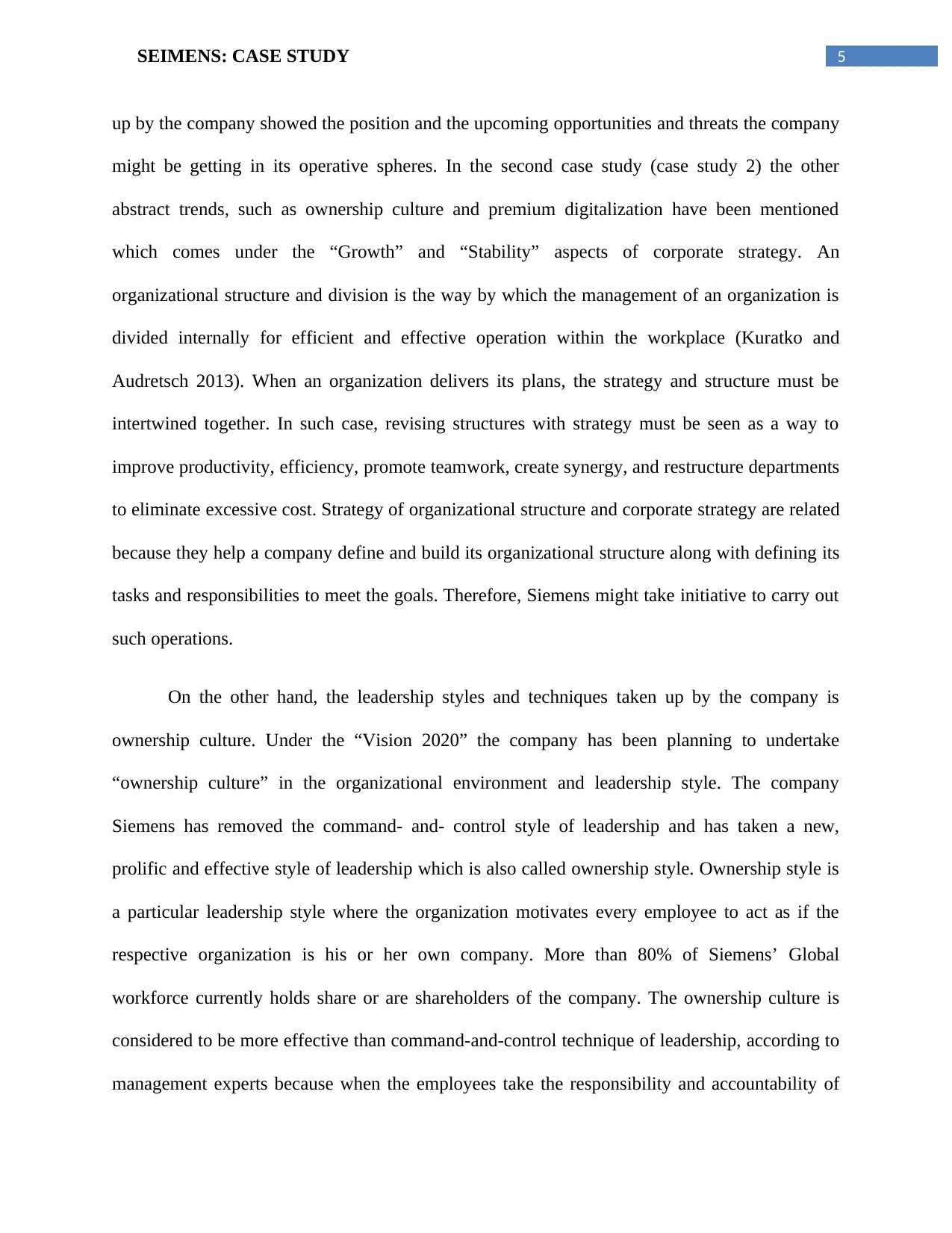
5SEIMENS: CASE STUDY
up by the company showed the position and the upcoming opportunities and threats the company
might be getting in its operative spheres. In the second case study (case study 2) the other
abstract trends, such as ownership culture and premium digitalization have been mentioned
which comes under the “Growth” and “Stability” aspects of corporate strategy. An
organizational structure and division is the way by which the management of an organization is
divided internally for efficient and effective operation within the workplace (Kuratko and
Audretsch 2013). When an organization delivers its plans, the strategy and structure must be
intertwined together. In such case, revising structures with strategy must be seen as a way to
improve productivity, efficiency, promote teamwork, create synergy, and restructure departments
to eliminate excessive cost. Strategy of organizational structure and corporate strategy are related
because they help a company define and build its organizational structure along with defining its
tasks and responsibilities to meet the goals. Therefore, Siemens might take initiative to carry out
such operations.
On the other hand, the leadership styles and techniques taken up by the company is
ownership culture. Under the “Vision 2020” the company has been planning to undertake
“ownership culture” in the organizational environment and leadership style. The company
Siemens has removed the command- and- control style of leadership and has taken a new,
prolific and effective style of leadership which is also called ownership style. Ownership style is
a particular leadership style where the organization motivates every employee to act as if the
respective organization is his or her own company. More than 80% of Siemens’ Global
workforce currently holds share or are shareholders of the company. The ownership culture is
considered to be more effective than command-and-control technique of leadership, according to
management experts because when the employees take the responsibility and accountability of
up by the company showed the position and the upcoming opportunities and threats the company
might be getting in its operative spheres. In the second case study (case study 2) the other
abstract trends, such as ownership culture and premium digitalization have been mentioned
which comes under the “Growth” and “Stability” aspects of corporate strategy. An
organizational structure and division is the way by which the management of an organization is
divided internally for efficient and effective operation within the workplace (Kuratko and
Audretsch 2013). When an organization delivers its plans, the strategy and structure must be
intertwined together. In such case, revising structures with strategy must be seen as a way to
improve productivity, efficiency, promote teamwork, create synergy, and restructure departments
to eliminate excessive cost. Strategy of organizational structure and corporate strategy are related
because they help a company define and build its organizational structure along with defining its
tasks and responsibilities to meet the goals. Therefore, Siemens might take initiative to carry out
such operations.
On the other hand, the leadership styles and techniques taken up by the company is
ownership culture. Under the “Vision 2020” the company has been planning to undertake
“ownership culture” in the organizational environment and leadership style. The company
Siemens has removed the command- and- control style of leadership and has taken a new,
prolific and effective style of leadership which is also called ownership style. Ownership style is
a particular leadership style where the organization motivates every employee to act as if the
respective organization is his or her own company. More than 80% of Siemens’ Global
workforce currently holds share or are shareholders of the company. The ownership culture is
considered to be more effective than command-and-control technique of leadership, according to
management experts because when the employees take the responsibility and accountability of
⊘ This is a preview!⊘
Do you want full access?
Subscribe today to unlock all pages.

Trusted by 1+ million students worldwide
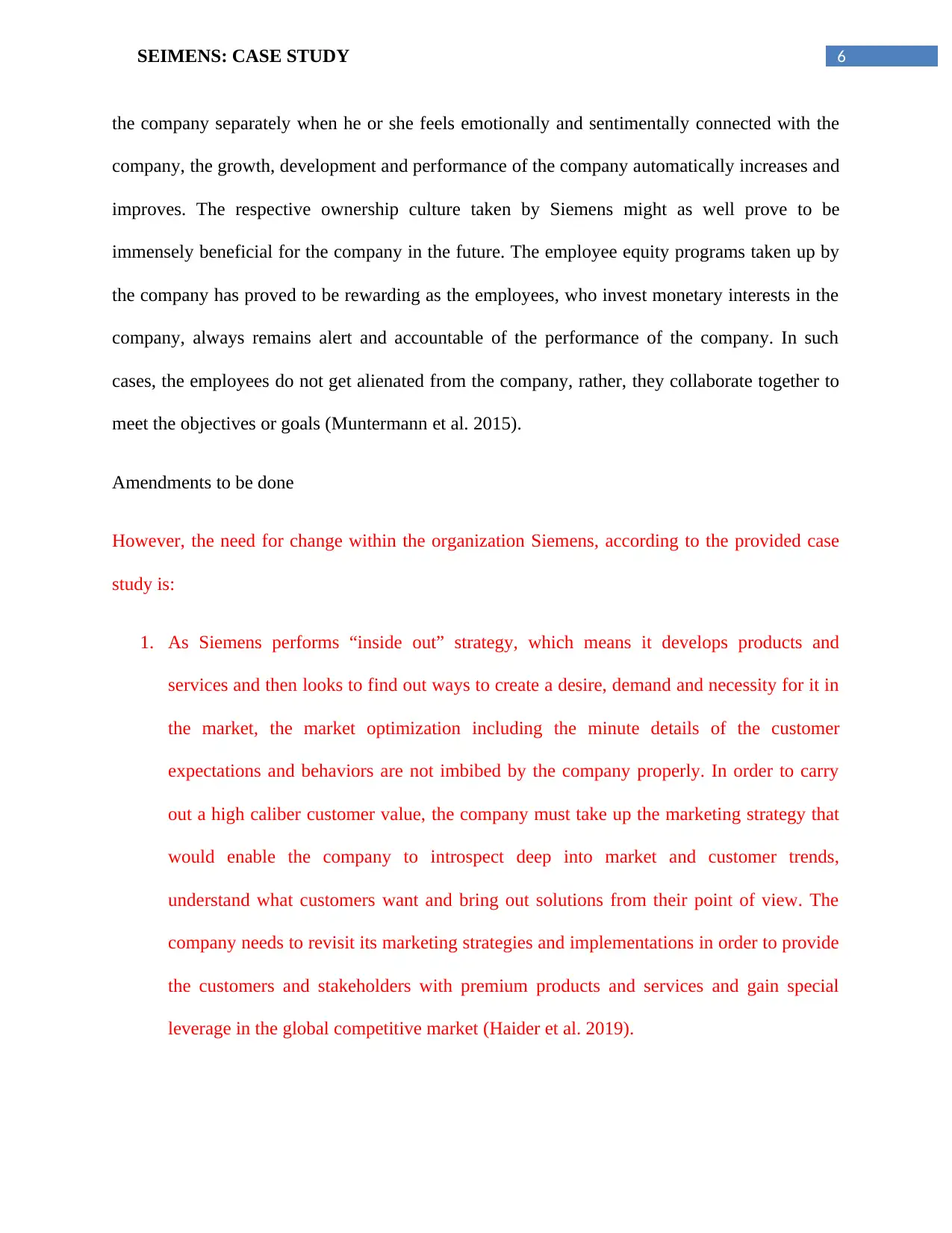
6SEIMENS: CASE STUDY
the company separately when he or she feels emotionally and sentimentally connected with the
company, the growth, development and performance of the company automatically increases and
improves. The respective ownership culture taken by Siemens might as well prove to be
immensely beneficial for the company in the future. The employee equity programs taken up by
the company has proved to be rewarding as the employees, who invest monetary interests in the
company, always remains alert and accountable of the performance of the company. In such
cases, the employees do not get alienated from the company, rather, they collaborate together to
meet the objectives or goals (Muntermann et al. 2015).
Amendments to be done
However, the need for change within the organization Siemens, according to the provided case
study is:
1. As Siemens performs “inside out” strategy, which means it develops products and
services and then looks to find out ways to create a desire, demand and necessity for it in
the market, the market optimization including the minute details of the customer
expectations and behaviors are not imbibed by the company properly. In order to carry
out a high caliber customer value, the company must take up the marketing strategy that
would enable the company to introspect deep into market and customer trends,
understand what customers want and bring out solutions from their point of view. The
company needs to revisit its marketing strategies and implementations in order to provide
the customers and stakeholders with premium products and services and gain special
leverage in the global competitive market (Haider et al. 2019).
the company separately when he or she feels emotionally and sentimentally connected with the
company, the growth, development and performance of the company automatically increases and
improves. The respective ownership culture taken by Siemens might as well prove to be
immensely beneficial for the company in the future. The employee equity programs taken up by
the company has proved to be rewarding as the employees, who invest monetary interests in the
company, always remains alert and accountable of the performance of the company. In such
cases, the employees do not get alienated from the company, rather, they collaborate together to
meet the objectives or goals (Muntermann et al. 2015).
Amendments to be done
However, the need for change within the organization Siemens, according to the provided case
study is:
1. As Siemens performs “inside out” strategy, which means it develops products and
services and then looks to find out ways to create a desire, demand and necessity for it in
the market, the market optimization including the minute details of the customer
expectations and behaviors are not imbibed by the company properly. In order to carry
out a high caliber customer value, the company must take up the marketing strategy that
would enable the company to introspect deep into market and customer trends,
understand what customers want and bring out solutions from their point of view. The
company needs to revisit its marketing strategies and implementations in order to provide
the customers and stakeholders with premium products and services and gain special
leverage in the global competitive market (Haider et al. 2019).
Paraphrase This Document
Need a fresh take? Get an instant paraphrase of this document with our AI Paraphraser
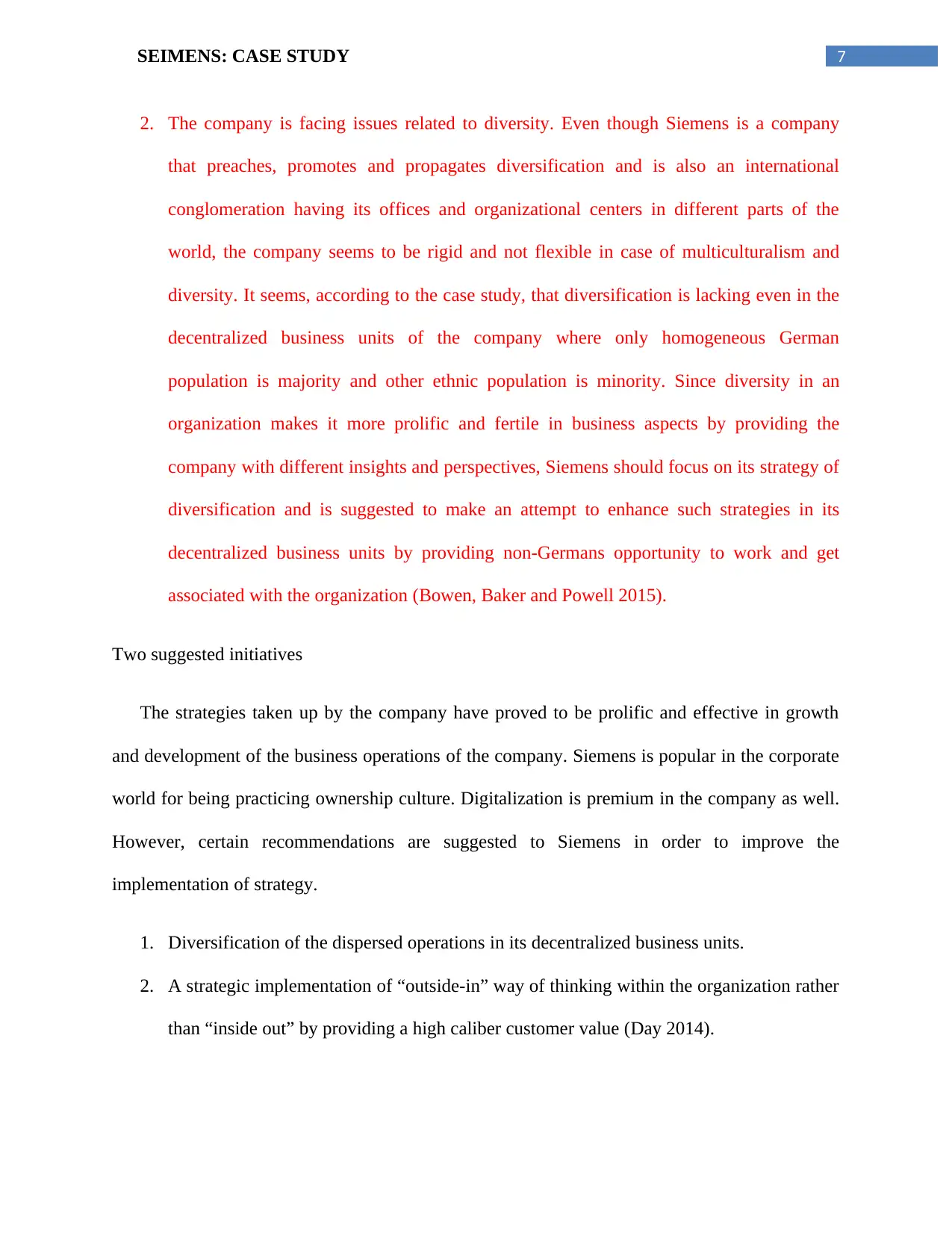
7SEIMENS: CASE STUDY
2. The company is facing issues related to diversity. Even though Siemens is a company
that preaches, promotes and propagates diversification and is also an international
conglomeration having its offices and organizational centers in different parts of the
world, the company seems to be rigid and not flexible in case of multiculturalism and
diversity. It seems, according to the case study, that diversification is lacking even in the
decentralized business units of the company where only homogeneous German
population is majority and other ethnic population is minority. Since diversity in an
organization makes it more prolific and fertile in business aspects by providing the
company with different insights and perspectives, Siemens should focus on its strategy of
diversification and is suggested to make an attempt to enhance such strategies in its
decentralized business units by providing non-Germans opportunity to work and get
associated with the organization (Bowen, Baker and Powell 2015).
Two suggested initiatives
The strategies taken up by the company have proved to be prolific and effective in growth
and development of the business operations of the company. Siemens is popular in the corporate
world for being practicing ownership culture. Digitalization is premium in the company as well.
However, certain recommendations are suggested to Siemens in order to improve the
implementation of strategy.
1. Diversification of the dispersed operations in its decentralized business units.
2. A strategic implementation of “outside-in” way of thinking within the organization rather
than “inside out” by providing a high caliber customer value (Day 2014).
2. The company is facing issues related to diversity. Even though Siemens is a company
that preaches, promotes and propagates diversification and is also an international
conglomeration having its offices and organizational centers in different parts of the
world, the company seems to be rigid and not flexible in case of multiculturalism and
diversity. It seems, according to the case study, that diversification is lacking even in the
decentralized business units of the company where only homogeneous German
population is majority and other ethnic population is minority. Since diversity in an
organization makes it more prolific and fertile in business aspects by providing the
company with different insights and perspectives, Siemens should focus on its strategy of
diversification and is suggested to make an attempt to enhance such strategies in its
decentralized business units by providing non-Germans opportunity to work and get
associated with the organization (Bowen, Baker and Powell 2015).
Two suggested initiatives
The strategies taken up by the company have proved to be prolific and effective in growth
and development of the business operations of the company. Siemens is popular in the corporate
world for being practicing ownership culture. Digitalization is premium in the company as well.
However, certain recommendations are suggested to Siemens in order to improve the
implementation of strategy.
1. Diversification of the dispersed operations in its decentralized business units.
2. A strategic implementation of “outside-in” way of thinking within the organization rather
than “inside out” by providing a high caliber customer value (Day 2014).
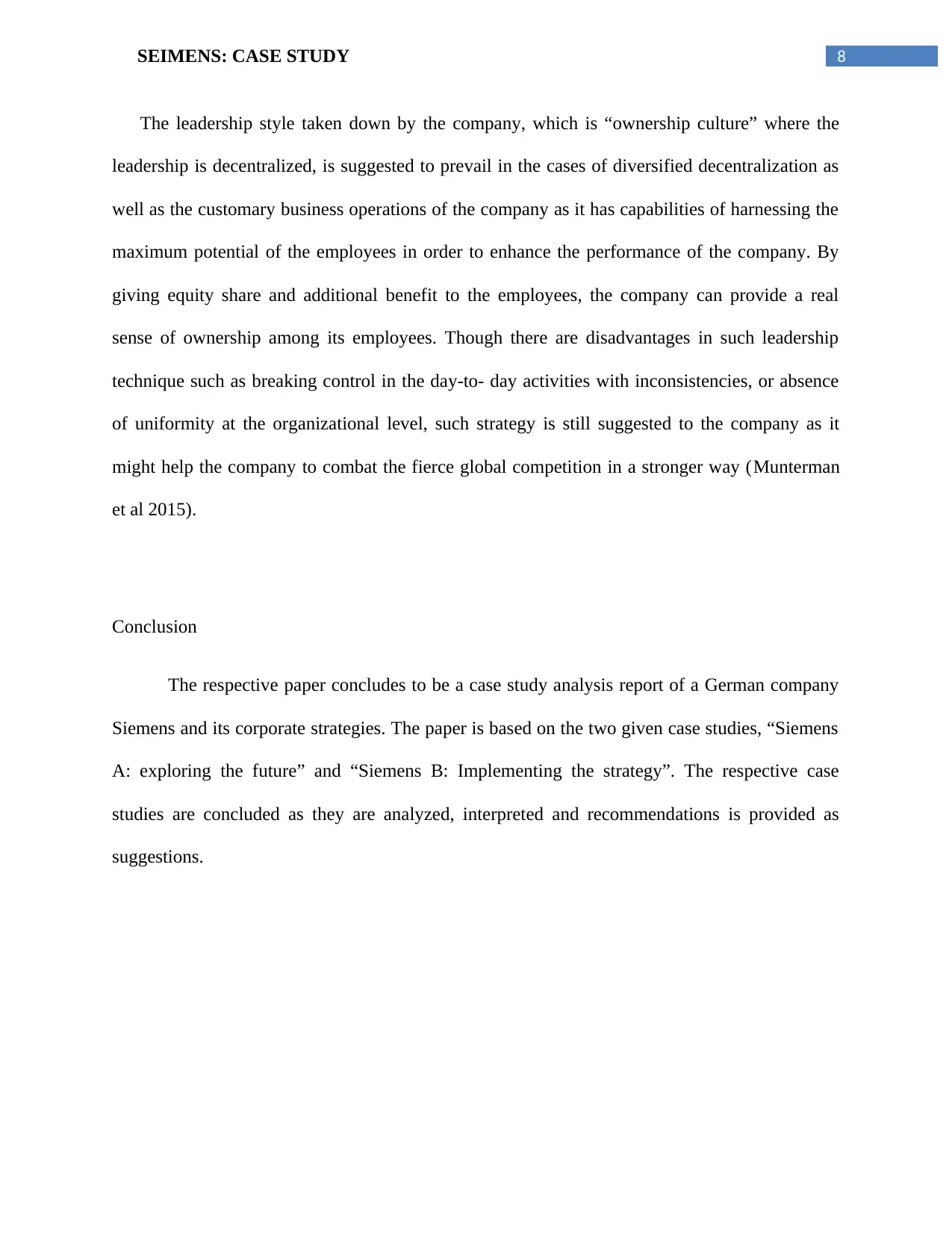
8SEIMENS: CASE STUDY
The leadership style taken down by the company, which is “ownership culture” where the
leadership is decentralized, is suggested to prevail in the cases of diversified decentralization as
well as the customary business operations of the company as it has capabilities of harnessing the
maximum potential of the employees in order to enhance the performance of the company. By
giving equity share and additional benefit to the employees, the company can provide a real
sense of ownership among its employees. Though there are disadvantages in such leadership
technique such as breaking control in the day-to- day activities with inconsistencies, or absence
of uniformity at the organizational level, such strategy is still suggested to the company as it
might help the company to combat the fierce global competition in a stronger way (Munterman
et al 2015).
Conclusion
The respective paper concludes to be a case study analysis report of a German company
Siemens and its corporate strategies. The paper is based on the two given case studies, “Siemens
A: exploring the future” and “Siemens B: Implementing the strategy”. The respective case
studies are concluded as they are analyzed, interpreted and recommendations is provided as
suggestions.
The leadership style taken down by the company, which is “ownership culture” where the
leadership is decentralized, is suggested to prevail in the cases of diversified decentralization as
well as the customary business operations of the company as it has capabilities of harnessing the
maximum potential of the employees in order to enhance the performance of the company. By
giving equity share and additional benefit to the employees, the company can provide a real
sense of ownership among its employees. Though there are disadvantages in such leadership
technique such as breaking control in the day-to- day activities with inconsistencies, or absence
of uniformity at the organizational level, such strategy is still suggested to the company as it
might help the company to combat the fierce global competition in a stronger way (Munterman
et al 2015).
Conclusion
The respective paper concludes to be a case study analysis report of a German company
Siemens and its corporate strategies. The paper is based on the two given case studies, “Siemens
A: exploring the future” and “Siemens B: Implementing the strategy”. The respective case
studies are concluded as they are analyzed, interpreted and recommendations is provided as
suggestions.
⊘ This is a preview!⊘
Do you want full access?
Subscribe today to unlock all pages.

Trusted by 1+ million students worldwide
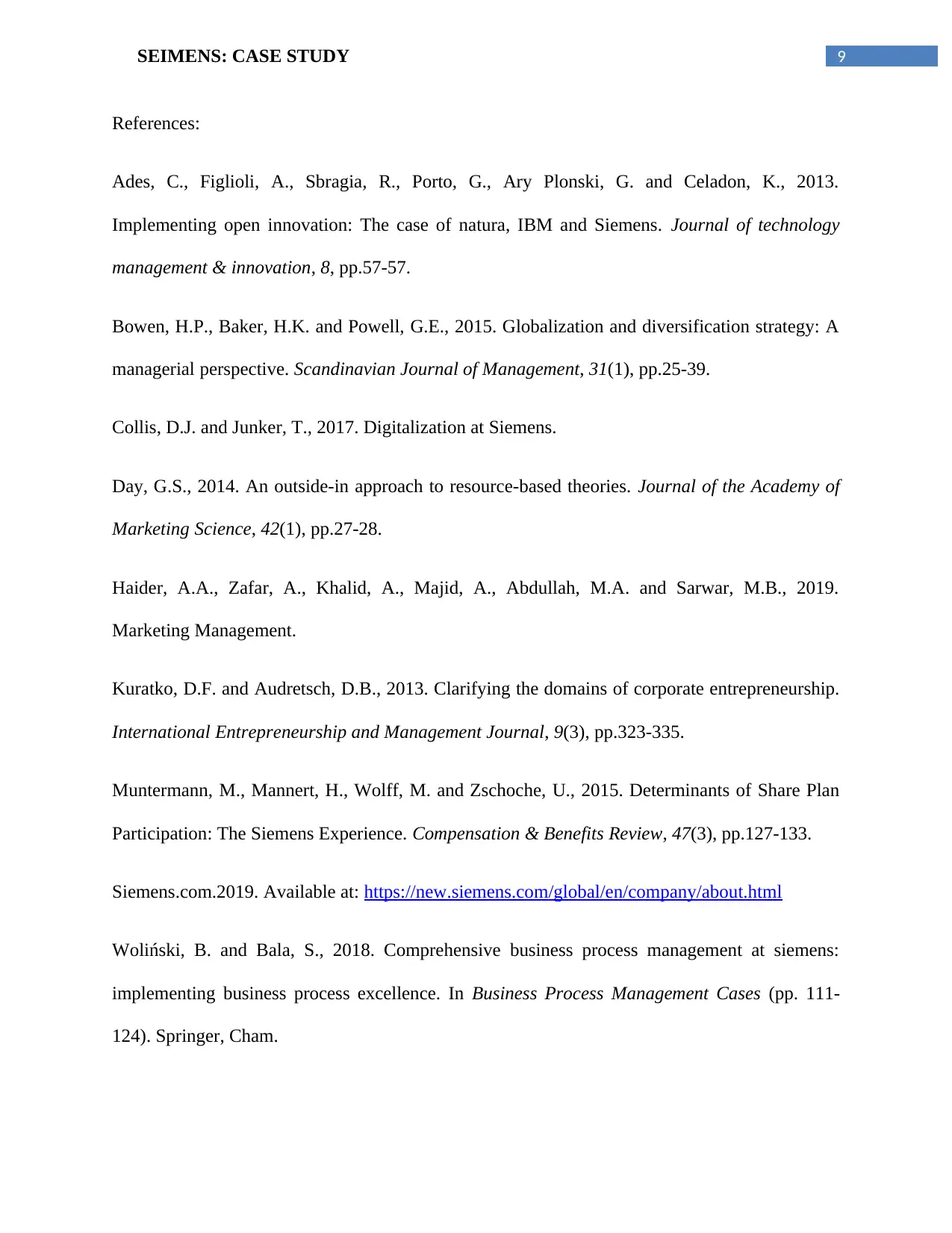
9SEIMENS: CASE STUDY
References:
Ades, C., Figlioli, A., Sbragia, R., Porto, G., Ary Plonski, G. and Celadon, K., 2013.
Implementing open innovation: The case of natura, IBM and Siemens. Journal of technology
management & innovation, 8, pp.57-57.
Bowen, H.P., Baker, H.K. and Powell, G.E., 2015. Globalization and diversification strategy: A
managerial perspective. Scandinavian Journal of Management, 31(1), pp.25-39.
Collis, D.J. and Junker, T., 2017. Digitalization at Siemens.
Day, G.S., 2014. An outside-in approach to resource-based theories. Journal of the Academy of
Marketing Science, 42(1), pp.27-28.
Haider, A.A., Zafar, A., Khalid, A., Majid, A., Abdullah, M.A. and Sarwar, M.B., 2019.
Marketing Management.
Kuratko, D.F. and Audretsch, D.B., 2013. Clarifying the domains of corporate entrepreneurship.
International Entrepreneurship and Management Journal, 9(3), pp.323-335.
Muntermann, M., Mannert, H., Wolff, M. and Zschoche, U., 2015. Determinants of Share Plan
Participation: The Siemens Experience. Compensation & Benefits Review, 47(3), pp.127-133.
Siemens.com.2019. Available at: https://new.siemens.com/global/en/company/about.html
Woliński, B. and Bala, S., 2018. Comprehensive business process management at siemens:
implementing business process excellence. In Business Process Management Cases (pp. 111-
124). Springer, Cham.
References:
Ades, C., Figlioli, A., Sbragia, R., Porto, G., Ary Plonski, G. and Celadon, K., 2013.
Implementing open innovation: The case of natura, IBM and Siemens. Journal of technology
management & innovation, 8, pp.57-57.
Bowen, H.P., Baker, H.K. and Powell, G.E., 2015. Globalization and diversification strategy: A
managerial perspective. Scandinavian Journal of Management, 31(1), pp.25-39.
Collis, D.J. and Junker, T., 2017. Digitalization at Siemens.
Day, G.S., 2014. An outside-in approach to resource-based theories. Journal of the Academy of
Marketing Science, 42(1), pp.27-28.
Haider, A.A., Zafar, A., Khalid, A., Majid, A., Abdullah, M.A. and Sarwar, M.B., 2019.
Marketing Management.
Kuratko, D.F. and Audretsch, D.B., 2013. Clarifying the domains of corporate entrepreneurship.
International Entrepreneurship and Management Journal, 9(3), pp.323-335.
Muntermann, M., Mannert, H., Wolff, M. and Zschoche, U., 2015. Determinants of Share Plan
Participation: The Siemens Experience. Compensation & Benefits Review, 47(3), pp.127-133.
Siemens.com.2019. Available at: https://new.siemens.com/global/en/company/about.html
Woliński, B. and Bala, S., 2018. Comprehensive business process management at siemens:
implementing business process excellence. In Business Process Management Cases (pp. 111-
124). Springer, Cham.
1 out of 10
Related Documents
Your All-in-One AI-Powered Toolkit for Academic Success.
+13062052269
info@desklib.com
Available 24*7 on WhatsApp / Email
![[object Object]](/_next/static/media/star-bottom.7253800d.svg)
Unlock your academic potential
Copyright © 2020–2025 A2Z Services. All Rights Reserved. Developed and managed by ZUCOL.





